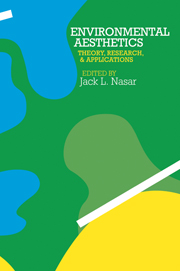Book contents
- Frontmatter
- Contents
- List of figures
- List of tables
- List of contributors and participants
- Acknowledgments
- Preface
- Section I Theory
- Section II Empirical studies
- Editor's introduction
- A Methodological comments
- B Architectural interiors
- C Architectural exteriors
- D Urban scenes
- E Natural and rural scenes
- Editor's introduction
- 22 Dimensions of meaning in the perception of natural settings and their relationship to aesthetic response
- 23 A cognitive analysis of preference for field-and-forest environments
- 24 The emotional quality of scenes and observation points: a look at prospect and refuge
- 25 Aesthetic preference for rural landscapes: some resident and visitor differences
- 26 Familiarity and preference: a cross-cultural analysis
- Section III Applications
- References
- Index of authors
- Subject index
23 - A cognitive analysis of preference for field-and-forest environments
Published online by Cambridge University Press: 05 September 2013
- Frontmatter
- Contents
- List of figures
- List of tables
- List of contributors and participants
- Acknowledgments
- Preface
- Section I Theory
- Section II Empirical studies
- Editor's introduction
- A Methodological comments
- B Architectural interiors
- C Architectural exteriors
- D Urban scenes
- E Natural and rural scenes
- Editor's introduction
- 22 Dimensions of meaning in the perception of natural settings and their relationship to aesthetic response
- 23 A cognitive analysis of preference for field-and-forest environments
- 24 The emotional quality of scenes and observation points: a look at prospect and refuge
- 25 Aesthetic preference for rural landscapes: some resident and visitor differences
- 26 Familiarity and preference: a cross-cultural analysis
- Section III Applications
- References
- Index of authors
- Subject index
Summary
Natural environments fascinate human beings (R. Kaplan, 1983; S. Kaplan, 1977; S. Kaplan and Talbot, 1983). They like natural environments better than urban environments (Kaplan, Kaplan, and Wendt, 1972). Not surprisingly, many attempts by planners to improve urban environments have involved introducing elements of the natural environment into the urban setting. Herzog, Kaplan, and Kaplan (1982) have shown quite clearly that nature within an urban setting forms a distinct category in the minds of observers, a category rated higher in preference than all the other urban categories they investigated. Thus it is known that nature in general is highly valued and that it can be used to improve urban environments.
In a sense, however, we have just scratched the surface. Consider how much better a job urban planners could do in using nature effectively if they knew more about it. The more detailed information needed is of two kinds. First, it seems unlikely that nature is one homogeneous category. Surely, a broad sampling of scenes will reveal several categories of nature that are differentially preferred. Second, there must be some specific identifiable variables that account at least in part for reactions to natural environments. If such variables can be isolated and described, then they can be manipulated by planners.
The research reported in this paper was guided by a theoretical framework that specifically addresses the concerns just discussed. It has been called the informational approach by Levin (1976).
- Type
- Chapter
- Information
- Environmental AestheticsTheory, Research, and Application, pp. 343 - 356Publisher: Cambridge University PressPrint publication year: 1988
- 4
- Cited by



